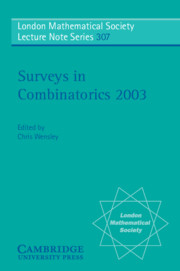Book contents
- Frontmatter
- Contents
- Preface
- W.T. Tutte, 1917–2002
- 1 Decompositions of complete graphs: embedding partial edge-colourings and the method of amalgamations
- 2 Combinatorial schemes for protecting digital content
- 3 Matroids and Coxeter groups
- 4 Defining sets in combinatorics: a survey
- 5 Finite projective planes with a large abelian group
- 6 Algorithmic aspects of graph homomorphisms
- 7 Counting lattice triangulations
- 8 Partition regular equations
- 9 Kostka–Foulkes polynomials and Macdonald spherical functions
7 - Counting lattice triangulations
Published online by Cambridge University Press: 05 May 2013
- Frontmatter
- Contents
- Preface
- W.T. Tutte, 1917–2002
- 1 Decompositions of complete graphs: embedding partial edge-colourings and the method of amalgamations
- 2 Combinatorial schemes for protecting digital content
- 3 Matroids and Coxeter groups
- 4 Defining sets in combinatorics: a survey
- 5 Finite projective planes with a large abelian group
- 6 Algorithmic aspects of graph homomorphisms
- 7 Counting lattice triangulations
- 8 Partition regular equations
- 9 Kostka–Foulkes polynomials and Macdonald spherical functions
Summary
Abstract
We discuss the problem to count, or, more modestly, to estimate the number f(m, n) of unimodular triangulations of the planar grid of size m × n.
Among other tools, we employ recursions that allow one to compute the (huge) number of triangulations for small m and rather large n by dynamic programming; we show that this computation can be done in polynomial time if m is fixed, and present computational results from our implementation of this approach.
We also present new upper and lower bounds for large m and n, and we report about results obtained from a computer simulation of the random walk that is generated by flips.
Introduction
An innocent little combinatorial counting problem asks for the number of triangulations of a finite grid of size m × n. That is, for m,n ≥ 1 we define Pm,n := {0,1,…, m} × {0,1,…, n}, “the grid”. Equivalently, the point configuration Pm,n consists of all points of the integer lattice Z2 in the lattice rectangle conv(Pm,n) = [0, m] × [0, n] of area mn. Every triangulation of this rectangle point set that uses all the points in Pm,n has (m + 1)(n + 1) = ∣Pm, n∣ vertices, 2mn facets/triangles, and 3mn + m + n edges, 2 (m + n) of them on the boundary, the other 3mn – m – n ones in the interior. All the triangles are minimal lattice triangles of area ½ (that is, of determinant 1), which are referred to as unimodular triangles.
- Type
- Chapter
- Information
- Surveys in Combinatorics 2003 , pp. 277 - 308Publisher: Cambridge University PressPrint publication year: 2003
- 10
- Cited by

